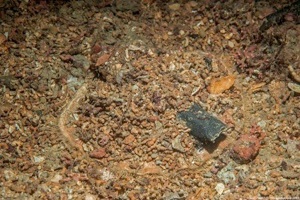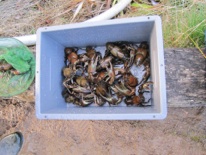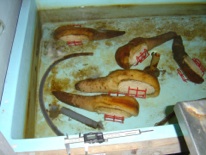Behavioural energetics of invertebrates to improve conservation and aquaculture practices

Anthony Robson




My research in the main covers four topics, all of which primarily concern invertebrate physiology and energetics: the respiratory physiology, energetics and behaviour of aquatic invertebrates; the relationships between the behaviour, ecology and energetics of aquatic/terrestrial invasive/endangered crustaceans; the development of the 'accelerometry technique' as a method for quantifying behaviour and energy expenditure in small animals, including estimating metabolism when anaerobic metabolism is prominent; and improving human health, including encouraging shellfish consumption. My current research takes a comparative approach in seeking to quantify the energetic costs for species in specific situations where energy expenditure can be affected by environmental specifics or individual variation, and changes in such could have a marked effect on fitness. For example, intra-specific variations in the metabolic rate of invertebrates and how this relates to their survival; the calories expended by invertebrates and how this relates to body mass. Fundamental to such questions is trying to understand the variability in behavioural and physiological adaptations of animals, in two respects. First, in terms of adaptive plasticity to a changing environment including epigenetics and ‘invertebrate personality.’ Second, in terms of variations in the adaptiveness of individuals within a population. Behavioural, physiological and energetic measures in combination enable me to answer fundamental questions about the plasticity of invertebrates.
Publications
Refereed publications
AA Robson, LG Halsey, L Chauvaud (2016) Feet, heat and scallops: what is the cost of anthropogenic disturbance in
bivalve aquaculture? R. Soc. open sci. 3: 150679.
A Jolivet, L Chauvaud, J Thébault, AA Robson, P Dumas, G Amos, A Lorrain (2015) Circadian behaviour of Tectus (Trochus) niloticus in the southwest Pacific inferred from accelerometry. Movement ecology 3 (1), 1-12
LG Halsey, PGD Matthews, EL Rezende, L Chauvaud, AA Robson (2015) The interactions between temperature and activity levels in driving metabolic rate: theory, with empirical validation from contrasting ectotherms. Oecologia 177 (4), 1117-1129
AA Robson, RP Mansfield (2014) Overinflated behavioural energetics: using dynamic livepage.apple.co.jpbody acceleration to accurately measure behaviour duration and estimate energy expenditure. Aquatic Biology 21 (2), 121-126
RP Mansfield, AA Robson (2013) BEnergetix: an R package to calculate behavioural time-energy budgets from acceleration, metabolic rate and environmental data. Aquatic Biology 21 (2), 121-126
AA Robson (2013) Preventing the epidemic of non-communicable diseases: an overview. Bioactive Food as Dietary Interventions for Liver and Gastrointestinal Disease 383-400
AA Robson (2013) Preventing the epidemic of mental ill health: an overview. Bioactive Food as Dietary Interventions for the Aging Population, 173-186
AA Robson (2013) Chocolate Bars Based on Human Nutritional Requirements. Chocolate in Health and Nutrition 7 (part 2), 143-148
L Di Iorio, C Gervaise, V Jaud, AA Robson, L Chauvaud (2012) Hydrophone detects cracking sounds: Non-intrusive monitoring of bivalve movement. Journal of Experimental Marine Biology and Ecology 432, 9-16
AA Robson (2012) Tackling obesity: can food processing be a solution rather than a problem? 2 Monographic supplement series: Weight Management 23, 10-11
AA Robson, L Chauvaud, RP Wilson, LG Halsey (2012) Small actions, big costs: the behavioural energetics of a commercially important invertebrate. Journal of the Royal Society Interface 9 (72), 1486-1498
AA Robson (2011) Food nanotechnology: water is the key to lowering the energy density of processed foods. Nutrition and Health 20 (3-4), 231-236
AA Robson, C Garcia De Leaniz, RP Wilson, LG Halsey (2010) Behavioural adaptations of mussels to varying levels of food availability and predation risk. Journal of Molluscan Studies 76 (4), 348-353
AA Robson (2010) Creating convenience food based on human nutritional requirements. Azo Nanotechnology 2635
AA Robson, C Garcia de Leaniz, RP Wilson, LG Halsey (2010) Effect of anthropogenic feeding regimes on activity rhythms of laboratory mussels exposed to natural light. Hydrobiologia 655, 197-204
AA Robson (2010) Nanotechnologies and food: 1st report of session 2009-10: Vol. 2 Evidence. House of Lords Papers 2, 336-361
S Busson, C Gervaise, B Amélie, K Bazile, J Virgine, L Chauvaud, AA Robson (2010) Higher-order statistics for bioacoustic click detection. 10ème Congrès Français d’Acoustique. Lyon, France
B Kinda, C Gervaise, L Chauvaud, V Jaud, S Busson, T Robson (2010) " SONO-PROXY": UN CAPTEUR NON INTRUSIF DU COMPORTEMENT DE LA COQUILLE SAINT-JACQUES. Annales Hydrographiques 7 (776), 8.1-8.8
AA Robson (2009) Preventing diet induced disease: bioavailable nutrient-rich, low-energy-dense diets.Nutrition and Health 20 (2), 135-166
AA Robson, GR Thomas, CG De Leaniz, RP Wilson (2009) Valve gape and exhalant pumping in bivalves: optimization of measurement. Aquatic Biology 6, 191-200
AA Robson (2008) Gaping at environmental variability: How do bivalves react to changing circumstance?
AA Robson, MS Kelly, JW Latchford (2007) Effect of temperature on the spoilage rate of whole, unprocessed crabs: Carcinus maenas, Necora puber and Cancer pagurus. Food Microbiology 24 (4), 419-424
A Robson, R Wilson, CG de Leaniz (2007) Mussels flexing their muscles: a new method for quantifying bivalve behaviour. Marine Biology 151 (3), 1195-1204
A Robson (2006)Shellfish view of omega-3 and sustainable fisheries. Nature 444 (7122), 1002-1002
E-mail: : anthony.robson@aori.u-tokyo.ac.jp